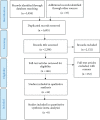A Qualitative Systematic Review of Effects of Provider Characteristics and Nonverbal Behavior on Pain, and Placebo and Nocebo Effects
- PMID: 31037059
- PMCID: PMC6476260
- DOI: 10.3389/fpsyt.2019.00242
A Qualitative Systematic Review of Effects of Provider Characteristics and Nonverbal Behavior on Pain, and Placebo and Nocebo Effects
Abstract
Background: Previous research has indicated that the sex, status, and nonverbal behaviors of experimenters or clinicians can contribute to reported pain, and placebo and nocebo effects in patients or research participants. However, no systematic review has been published. Objective: The aim of this study was to investigate the effects of experimenter/clinician characteristics and nonverbal behavior on pain, placebo, and nocebo effects. Methods: Using EmBase, Web of Knowledge, and PubMed databases, several literature searches were conducted to find studies that investigated the effects of the experimenter's/clinician's sex, status, and nonverbal behaviors on pain, placebo, and nocebo effects. Results: Thirty-four studies were included, 20 on the effects of characteristics of the experimenter/clinician, 11 on the role of nonverbal behaviors, and 3 on the effects of both nonverbal behaviors and characteristics of experimenters/clinicians on pain and placebo/nocebo effects. There was a tendency for experimenters/clinicians to induce lower pain report in participants of the opposite sex. Furthermore, higher confidence, competence, and professionalism of experimenters/clinicians resulted in lower pain report and higher placebo effects, whereas lower status of experimenters/clinicians such as lower confidence, competence, and professionalism generated higher reported pain and lower placebo effects. Positive nonverbal behaviors (e.g., smiling, strong tone of voice, more eye contact, more leaning toward the patient/participant, and more body gestures) contributed to lower reported pain and higher placebo effects, whereas negative nonverbal behaviors (i.e., no smile, monotonous tone of voice, no eye contact, leaning backward from the participant/patient, and no body gestures) contributed to higher reported pain and nocebo effects. Conclusion: Characteristics and nonverbal behaviors of experimenters/clinicians contribute to the elicitation and modulation of pain, placebo, and nocebo effects.
Keywords: clinician sex; contextual factors; experimenter characteristics; experimenter sex; nocebo effect; nonverbal behavior; pain; placebo effect.
Figures
Similar articles
-
Placebo Effects on Stress, but Not on Pain Reports. A Multi-Experiment Study.Front Psychol. 2021 Jun 7;12:639236. doi: 10.3389/fpsyg.2021.639236. eCollection 2021. Front Psychol. 2021. PMID: 34163396 Free PMC article.
-
Clinical relevance of contextual factors as triggers of placebo and nocebo effects in musculoskeletal pain.BMC Musculoskelet Disord. 2018 Jan 22;19(1):27. doi: 10.1186/s12891-018-1943-8. BMC Musculoskelet Disord. 2018. PMID: 29357856 Free PMC article. Review.
-
"Big girls don't cry": the effect of the experimenter's sex and pain catastrophising on pain.Scand J Pain. 2021 Feb 10;21(3):617-627. doi: 10.1515/sjpain-2020-0157. Print 2021 Jul 27. Scand J Pain. 2021. PMID: 33565286
-
Neurotransmitter systems involved in placebo and nocebo effects in healthy participants and patients with chronic pain: a systematic review.Pain. 2020 Jan;161(1):11-23. doi: 10.1097/j.pain.0000000000001682. Pain. 2020. PMID: 31453980
-
Systematic manipulation of experimenters' non-verbal behaviors for the investigation of pain reports and placebo effects.Front Psychol. 2023 Oct 31;14:1248127. doi: 10.3389/fpsyg.2023.1248127. eCollection 2023. Front Psychol. 2023. PMID: 38023052 Free PMC article.
Cited by
-
What Psychological Factors Make Individuals Believe They Are Infected by Coronavirus 2019?Front Psychol. 2021 Apr 22;12:667722. doi: 10.3389/fpsyg.2021.667722. eCollection 2021. Front Psychol. 2021. PMID: 33967926 Free PMC article.
-
Differences between experimental and placebo arms in manual therapy trials: a methodological review.BMC Med Res Methodol. 2022 Aug 8;22(1):219. doi: 10.1186/s12874-022-01704-8. BMC Med Res Methodol. 2022. PMID: 35941533 Free PMC article. Review.
-
Placebo Effects on Stress, but Not on Pain Reports. A Multi-Experiment Study.Front Psychol. 2021 Jun 7;12:639236. doi: 10.3389/fpsyg.2021.639236. eCollection 2021. Front Psychol. 2021. PMID: 34163396 Free PMC article.
-
Expectations about pain and analgesic treatment are shaped by medical providers' facial appearances: Evidence from five online clinical simulation experiments.Soc Sci Med. 2021 Jul;281:114091. doi: 10.1016/j.socscimed.2021.114091. Epub 2021 Jun 3. Soc Sci Med. 2021. PMID: 34126294 Free PMC article.
-
European Headache Federation recommendations for placebo and nocebo terminology.J Headache Pain. 2020 Sep 25;21(1):117. doi: 10.1186/s10194-020-01178-3. J Headache Pain. 2020. PMID: 32977761 Free PMC article.
References
Publication types
LinkOut - more resources
Full Text Sources


